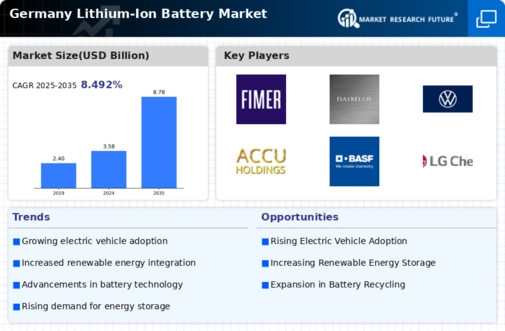Market Share
Germany lithium ion battery market Share Analysis
In the rapidly expanding landscape of lithium-ion battery markets, Germany stands as a pivotal player, navigating through a myriad of market share positioning strategies to maintain its competitive edge. One prominent approach adopted by companies in this sector is differentiation. Through innovation and technology, German firms strive to offer unique features and functionalities that set their products apart from competitors'. Whether it's enhancing energy density, improving charging times, or increasing durability, differentiation allows companies to capture niche segments of the market and build a loyal customer base.
Another vital strategy employed by players in the German lithium-ion battery market is cost leadership. With the increasing demand for electric vehicles (EVs) and renewable energy storage solutions, economies of scale become crucial. German companies leverage their expertise in manufacturing efficiency and supply chain management to drive down costs while maintaining quality. By offering competitive pricing, these firms can attract price-sensitive customers and gain significant market share, especially in price-driven segments.
Furthermore, market segmentation plays a pivotal role in Germany's lithium-ion battery market positioning. Companies carefully analyze the diverse needs and preferences of consumers, segmenting the market based on factors such as application (e.g., automotive, consumer electronics, energy storage) and performance requirements. By catering to specific segments with tailored products and marketing strategies, companies can effectively penetrate different market niches and maximize their market share.
Collaboration and partnerships also feature prominently in the market share positioning strategies of German lithium-ion battery companies. Recognizing the importance of ecosystem integration, firms often collaborate with other industry players, including automakers, energy companies, and research institutions. These partnerships enable companies to leverage complementary strengths, access new markets, and accelerate innovation. Whether it's joint development projects, strategic alliances, or supply chain partnerships, collaboration enhances the competitiveness of German firms in the global lithium-ion battery market.
Moreover, branding and marketing efforts play a crucial role in shaping market share positioning strategies. German companies emphasize their reputation for quality, reliability, and engineering excellence to differentiate themselves from competitors. Strong branding helps build trust and credibility among customers, driving demand for their products despite fierce competition. Through targeted marketing campaigns, companies effectively communicate their value proposition and resonate with their target audience, further solidifying their market position.
Additionally, sustainability and environmental considerations are increasingly influencing market share positioning strategies in the German lithium-ion battery market. As consumers become more environmentally conscious, there is a growing demand for eco-friendly and ethically sourced products. German companies prioritize sustainability initiatives, such as using recycled materials, reducing carbon footprint, and implementing responsible manufacturing practices. By aligning with sustainable values, companies not only appeal to environmentally conscious consumers but also meet regulatory requirements and enhance their brand image.
Furthermore, continuous innovation and research and development (R&D) investment are integral to maintaining a competitive edge in the German lithium-ion battery market. Companies allocate significant resources to R&D to stay at the forefront of technology advancements, whether it's improving battery performance, increasing energy density, or enhancing safety features. By continuously innovating, German firms can introduce cutting-edge products that address evolving customer needs and preferences, driving market adoption and solidifying their market share position.
The market share positioning strategies of the German lithium-ion battery market are multifaceted, encompassing differentiation, cost leadership, market segmentation, collaboration, branding, sustainability, and innovation. By leveraging these strategies effectively, German companies can navigate the competitive landscape, capture market share, and sustain growth in this dynamic and rapidly evolving industry.














Leave a Comment